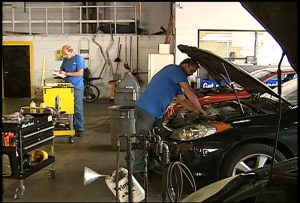It’s easy to talk about air pollution and how it impacts our quality of life in California today, but things have improved considerably. Decades back, from approximately the 1940s to 1970, smog was a constant brown haze over the Los Angeles basin, especially on sunny days.
Scientists call it photochemical smog which is a mix of pollutants that react to sunlight. This included volatile organic compounds, or VOCs, caused by burning gasoline.
For those who were around Los Angeles in the 1970s, they might remember the type of smog that we had back then. Thick and constant (although it did contribute to dramatic sunsets). People were noticing and feeling the effects of the heavy toxins in the air. A place like L.A. was the perfect mix for the thick brown haze thrived due to the activities of over 39 million people and a mountainous terrain that traps pollution. The consistently warm climate helped form ground-level ozone and other pollutants.
Air pollution became a concern throughout the United States and action was taken. The first steps to cleaner air included the passing of the Clean Air Act of 1970 and the Environmental Protection Agency. But it would take time for people to adjust to new regulations. Car manufacturers had to change. So did individuals and corporate habits. In 1972, the Bureau of Automotive Repair was established to regulate and license auto repair dealers, technicians, smog check stations, and brake and lamp adjustors.
If you’d like to dig deeper into California’s past with air pollution, here’s an informative article from Scientific American (https://blogs.scientificamerican.com/observations/the-decades-long-war-on-smog/). Since then, to use a 1970s slogan, we’ve come a long way, baby! Todays air pollution may not be gone, but it has improved significantly.
Smog Questions and Answers in California
Q. How much has air pollution improved?
A. According to the California Air Resources Board, since the 1970’s several pollutant levels have lowered by 75 – 99%. And carbon monoxide (CO2) has made the most significant drop.
Q. What is “ground-level ozone?
A. This low-level ozone layer is created by air pollutants like VOCs and other particulate matter. Unlike the ozone layer that protects us from UV light, it hovers around the ground. This smog layer is responsible for causing respiratory health issues like asthma, coughing, shortness of breath, and other lung problems.
What is happening to the ozone layer?
According to CalTech (https://scienceexchange.caltech.edu/topics/sustainability/what-causes-smog), the ozone layer is returning. That’s the layer creating a protective layer to block ultraviolet radiation from the sun. This ozone layer hovers about five miles above the ground. The worldwide community has been phasing out products, and the United Nations reports it may fully recover by 2066.
Q. Is there a listing of how specific auto models score on emissions?
A. Greencars.org (https://greenercars.org/) provides rankings for which vehicles score from “greenest” to “meanest.” The website also offers an emissions calculator for electric cars. As the site explains, sourcing and distributing the electricity required to operate an EV generally results in significant emissions.
Q. How old is the Bureau of Automotive Repair?
A. As of now, the BAR is over 50 years old! And plenty of changes have happened. Today, California has a highly regulated smog check industry. That’s good for the fight against air pollution, but with this kind of success comes a flipside: a regulatory agency that needs to remain relevant as it moves forward.
Smog Technicians are the Good Samaritans in the Fight for Cleaner Air!
The professionals frequently left out of these conversations are hard-working smog and auto repair technicians. They are at the front lines of clean air efforts. And it’s not easy work. A tech can get flak even with the best intentions and excellent work ethic. They might receive a complaint from a disgruntled customer, which can result in receiving an accusation letter from the Bureau of Automotive Repair. It isn’t fair. Smog technicians are the “good guys” doing their part for a cleaner environment. But it does happen, and for a state agency that needs to remain relevant, an unsuspecting smog professional may get caught up in a quota.
As a team of top-rated attorneys focused on fighting the Bureau of Auto Repair, we can help with smog questions and answers in California (https://automotivedefense.com/contact/).